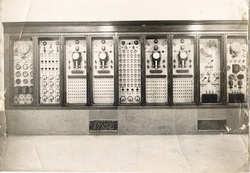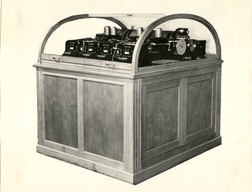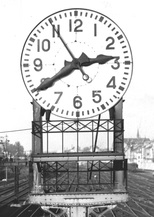Cosmo Time Systems was incorporated on 15 October 1920 as Horlogerie Contrôle Electricité S.A. by the Brillié engineers, inventors of a master clock, driven by an electromagnetically driven swing which could drive other slave clocks. H.C.E. soon gained fame as the expert in designing, manufacturing, installing and maintaining electrically driven clocks and time registration clocks. In 1968 the design of electronic products started and the name was changed to the current COSMO.
Cosmo was in at the start of many of major developments in the field of measuring time and the application of time-related solutions, which are still being used now, 100 years later.
A few examples:
Electric round-control for four simultanious rounds

Here you will see the 2-metre high control panel in the monumental building of the head office of the Bank Brussel Lambert which was still in active use in the year 1965. The entire building was equipped with electrical contacts that could only be activated with the watchman’s control keys. The time between two check points and the path to be followed were outlined in advance. When the sequence or the time between the points was not according to plan, the burglar alarm went off. Every check point gave an impulse to the printer, that recorded the time on a paper roll so it could be checked later. This method of guarding is still used everywhere today.
Talking clock at the phone and telegraph company

On the right is a picture of a speaking clock. “At the third beep, it will be exactly xx o’clock, with yy minutes and zz seconds”. You must have heard this and it is still in use, but purely electronically now. The voice was recorded (magnetised) on steel wire, with a reel for the hours, another one for the minutes and a third one for the seconds. The whole unit was operated by an electrical relay from the master clock which provided second-accurate impulses to start and stop the reading.
Railway electronic clock 3 meter in diameter

Here you see a clock driven by electrical impulses with a 3-meter diameter, which was installed in the Brussels train station where the North station is now located and where it could be seen by the passengers from a distance. There were no platform clocks yet as we know them now. You are looking in the direction of Schaarbeek, the platforms are behind you. The seconds hand was driven by a synchronous motor and stopped on the 59th second to wait for the next minute impulse of the master clock, before moving on. This system of the seconds hand waiting on the 59th second until the new minute is still being used in our and most European railway stations.
Cosmo has continued developing this specialty where know-how, knowledge, quality and service are the basis of success.
